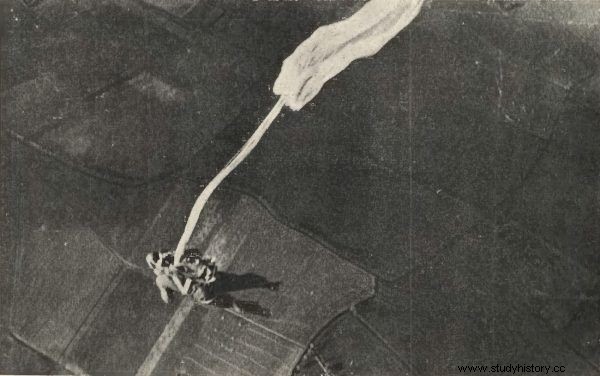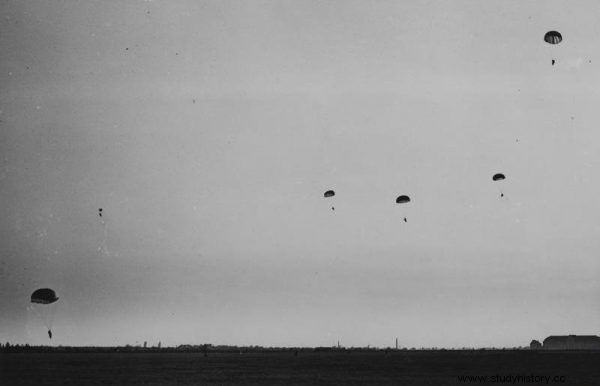These soldiers should be considered the first Allied special unit of the Second World War. They were to organize a ruthless hunt for German military commanders and NSDAP officers in East Prussia. And of course they were Poles.
In the spring of 1939, the Second Department of the General Staff of the Polish Army developed a plan to transfer special subversive and reconnaissance groups to East Prussia. Polish troops were to carry out actions to paralyze the German state administration and infrastructure there field and eliminate military and party dignitaries . Their transport into enemy territory was intended to be carried out by air.
Bydgoszcz commandos
In May 1939 in Bydgoszcz a Military Parachute Center was opened . It was there that the saboteurs were to be trained. Major Władysław Tuchółko was the commander of the center. Captains Kulesza and Rybicki, responsible for air transport, were subordinate to him. Lieutenant Kędzierski took care of the parachute and landing gear.
In the field of diversion, training was conducted by lieutenant Jerzy Górecki, sapper activities were taught by second lieutenant Jerzy Siegenfeld, and communication was taught by second lieutenant Wacław Malinowski. Parachute training was conducted by instructors from the Air and Gas Defense League:Antoni Grabowski, Julian Gębołyś and Feliks Zacharski. The center was assigned three Fokker F-VII / 3m transport aircraft with crews and technical staff.
The first two-month sabotage course for eighty officers and non-commissioned officers started at the beginning of June 1939. Preferred candidates who speak German or Russian , which clearly defined the future directions of activities of special groups. In addition, each of them had to be in excellent physical condition and had basic parachute training. As one of the students vividly put it, they were all lads as oaks .

A group jump of Polish paratroopers in the photo from the 1930s (source:public domain).
Each special group consisted of eight to ten soldiers with different specialties, which was to guarantee any type of mission . During the action, such a team was divided into three teams:shielding, engineer-destroying and communication teams.
Training
During the training, a lot of emphasis was placed on physical training, hand-to-hand combat and long, exhausting marches with full combat load. The soldiers also learned conspiratorial work and organize a resistance movement in the territory occupied by the enemy. All trainees underwent perfect parachute training, characteristic of elite special units .
They included jumps in difficult weather conditions, in strong winds, in rain or fog, and in various terrain conditions - in the forest, in the areas of water reservoirs and in swamps. The sapper training included learning how to effectively destroy a variety of industrial and communication facilities with the use of small amounts of explosives.
Equipment and weapons
In the center in Bydgoszcz, equipment was implemented and tested, which in the future was to be equipped not only by special teams, but also by the planned larger parachute unit. According to the paratroopers' requirements, the Warsaw communications equipment factory "Ava" produced a miniature radio station weighing only two kilograms .
Sappers under the leadership of Colonel Stelmachowski constructed a special small mine to destroy the tracks . It was the width of a railroad and exploded under pressure or lifting. The unit also received several test series "Mors" submachine guns for testing.
Spectacular action
The culmination of the course was the exercises carried out on August 2, 1939. Twenty saboteurs, commanded by Lieutenant Górecki, were to be dropped in the area of the Mińsk Mazowiecki - Tłuszcz railway line.

Each of the paratroopers trained in Bydgoszcz had to jump in difficult weather conditions. Preview photo of the parachute course, 1930s (source:public domain).
Their task was to actually destroy a small railway viaduct, about three hundred meters of track and an overhead telegraph line. The armament of the unit was:a machine gun (dropped in a container), a manual "Browning" machine gun, two "Mors" submachine guns, "Mauser" rifles, "Vis" pistols and hand grenades and explosives.
Lieutenant Jerzy Górecki first flew to reconnoiter the PWS-26 training plane and chose the target landing area, between the Cyców and Pustelnik railway stations. Then, in the afternoon, three jumpers from Fokkers were landed. For a greater surprise effect, the parachutes were opened with a five-second delay.
The general's surprised face - priceless
The landing party, then second lieutenant Malinowski, recalled that action as follows:
After hiding the parachutes at the edge of the forest, we immediately started our tasks. Under the protection of infantry, the sappers destroyed the viaduct, and then, running in the indicated direction, successively, in sections, the railway track. Moving along with the sappers, the communications group destroyed the overhead telegraph line.

On August 2, 1939, Bydgoszcz "saboteurs" finally had the opportunity to show how much they are worth. Preview photo. Second half of the 1930s (source:public domain).
Task completed within half an hour . When the end of the action was to be reported, the saboteurs were unexpectedly fired on with blank ammunition by an infantry unit guarding the railway. However, the late and stunned footmen quickly "silenced" the series with live ammunition of the shield unit and submachine guns "Mors".
There was one more waiting for the paratroopers, this time a nice surprise. A group of high-ranking officers, including generals, arrived at the action site. Malinowski continued:
Their eyes were amazed - they passed bent, broken rails, a damaged telegraph line. They stared with admiration at the perpetrators of such an instant destruction.

Demonstration parachute landing carried out in 1939 (source:public domain).
Training interrupted
After this demonstration action, the trainees went to their home units. It is incomprehensible that with such excellent training results, they were not made into a regular special unit. This potential has been wasted. Instead, from August 7 to September 16, 1939, another training camp for saboteurs was planned. This time, only forty soldiers were reserved. The Polish army was already preparing for the war.
The training in Bydgoszcz was interrupted on August 28, 1939 . Its participants and the entire staff of the center wanted to take air and rail transport to the Małaszewicze airport near Brest-on-the-Bug. There, on the last day of August, Major Władysław Tuchółko received an order to create three subversive groups from the students and prepare them for transfer to East Prussia.

Unfortunately, on September 1, 1939, around 5.30 am, a strong Luftwaffe air group bombed the airport and almost all planes there, including the center's Fokkers, were destroyed. Due to the lack of transport, the use of saboteurs in hostile terrain became impossible.
To make matters worse, Małaszewicze did not reach the railway line of the center, bombed on the tracks near Łowicz. Some of the equipment was lost with him. Finally, on September 13, Major Tuchółko decided to dissolve the Military Parachute Center.
